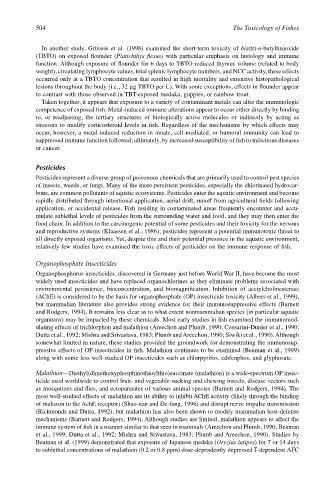Page 524 - The Toxicology of Fishes
P. 524
504 The Toxicology of Fishes
In another study, Grinwis et al. (1998) examined the short-term toxicity of bis(tri-n-butyltin)oxide
(TBTO) on exposed flounder (Platichthys flesus) with particular emphasis on histology and immune
function. Although exposure of flounder for 6 days to TBTO reduced thymus volume (related to body
weight), circulating lymphocyte values, total splenic lymphocyte numbers, and NCC activity, these effects
occurred only at a TBTO concentration that resulted in high mortality and extensive histopathological
lesions throughout the body (i.e., 32 µg TBTO per L). With some exceptions, effects in flounder appear
to contrast with those observed in TBT-exposed medaka, guppies, or rainbow trout.
Taken together, it appears that exposure to a variety of contaminant metals can alter the immunologic
competence of exposed fish. Metal-induced immune alterations appear to occur either directly by binding
to, or readjusting, the tertiary structures of biologically active molecules or indirectly by acting as
stressors to modify corticosteroid levels in fish. Regardless of the mechanisms by which effects may
occur, however, a metal-induced reduction in innate, cell-mediated, or humoral immunity can lead to
suppressed immune function followed, ultimately, by increased susceptibility of fish to infectious diseases
or cancer.
Pesticides
Pesticides represent a diverse group of poisonous chemicals that are primarily used to control pest species
of insects, weeds, or fungi. Many of the more persistent pesticides, especially the chlorinated hydrocar-
bons, are common pollutants of aquatic ecosystems. Pesticides enter the aquatic environment and become
rapidly distributed through intentional application, aerial drift, runoff from agricultural fields following
application, or accidental release. Fish residing in contaminated areas frequently encounter and accu-
mulate sublethal levels of pesticides from the surrounding water and food, and they may then enter the
food chain. In addition to the carcinogenic potential of some pesticides and their toxicity for the nervous
and reproductive systems (Klaassen et al., 1986), pesticides represent a potential immunotoxic threat to
all directly exposed organisms. Yet, despite this and their potential presence in the aquatic environment,
relatively few studies have examined the toxic effects of pesticides on the immune response of fish.
Organophosphate Insecticides
Organophosphorus insecticides, discovered in Germany just before World War II, have become the most
widely used insecticides and have replaced organochlorines as they eliminate problems associated with
environmental persistence, bioconcentration, and biomagnification. Inhibition of acetylcholinesterase
(AChE) is considered to be the basis for organophosphate (OP) insecticide toxicity (Albers et al., 1999),
but mammalian literature also provides strong evidence for their immunosuppressive effects (Barnett
and Rodgers, 1994). It remains less clear as to what extent nonmammalian species (in particular aquatic
organisms) may be impacted by these chemicals. Most early studies in fish examined the immunomod-
ulating effects of trichlorphon and malathion (Areechon and Plumb, 1990; Cossarini-Dunier et al., 1990;
Dutta et al., 1992; Mishra and Srivastava, 1983; Plumb and Areechon, 1990; Siwiki et al., 1990). Although
somewhat limited in nature, these studies provided the groundwork for demonstrating the immunosup-
pressive effects of OP insecticides in fish. Malathion continues to be examined (Beaman et al., 1999)
along with some less well-studied OP insecticides such as chlorpyrifos, edifenphos, and glyphosate.
Malathion—Diethyl(dimethoxyphosphinothioylthio)succinate (malathion) is a wide-spectrum OP insec-
ticide used worldwide to control fruit- and vegetable-sucking and chewing insects, disease vectors such
as mosquitoes and flies, and ectoparasites of various animal species (Barnett and Rodgers, 1994). The
most well-studied effects of malathion are its ability to inhibit AChE activity (likely through the binding
of malaxon to the AchE receptor) (Shao-nan and De-fang, 1996) and disrupt nerve impulse transmission
(Richmonds and Dutta, 1992), but malathion has also been shown to modify mammalian host-defense
mechanisms (Barnett and Rodgers, 1994). Although studies are limited, malathion appears to affect the
immune system of fish in a manner similar to that seen in mammals (Areechon and Plumb, 1990; Beaman
et al., 1999; Dutta et al., 1992; Mishra and Srivastava, 1983; Plumb and Areechon, 1990). Studies by
Beaman et al. (1999) demonstrated that exposure of Japanese medaka (Oryzias latipes) for 7 or 14 days
to sublethal concentrations of malathion (0.2 or 0.8 ppm) dose-dependently depressed T-dependent AFC

